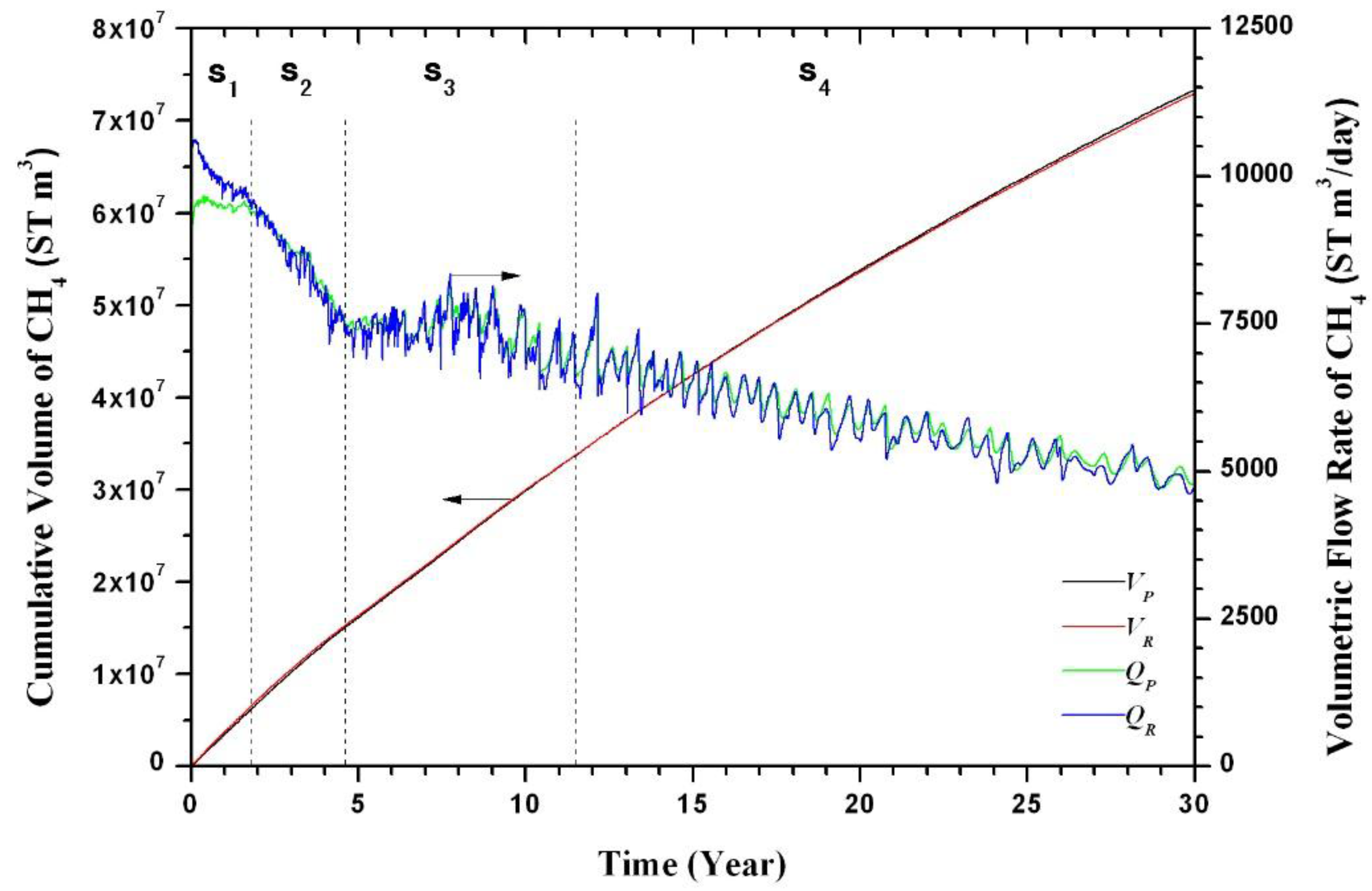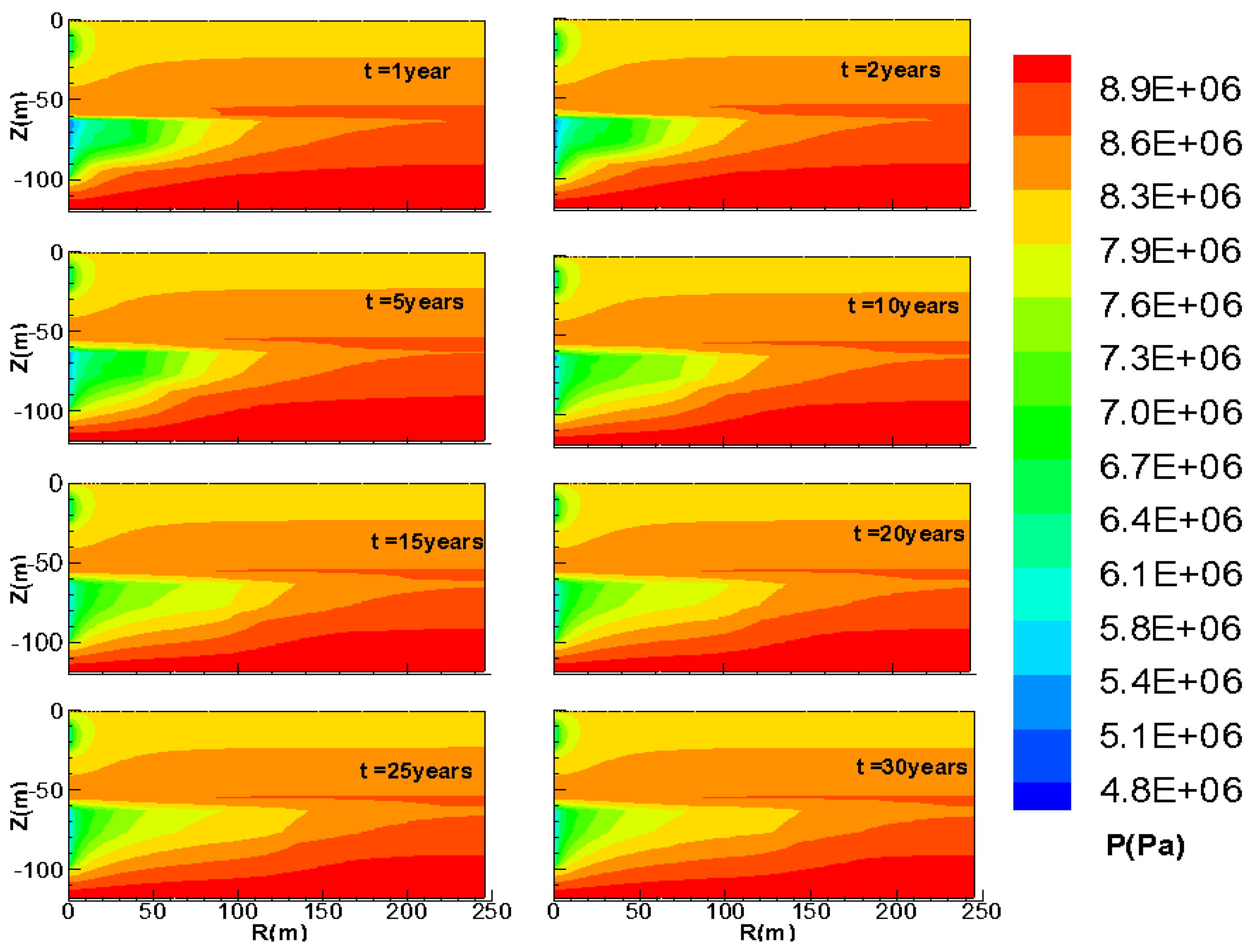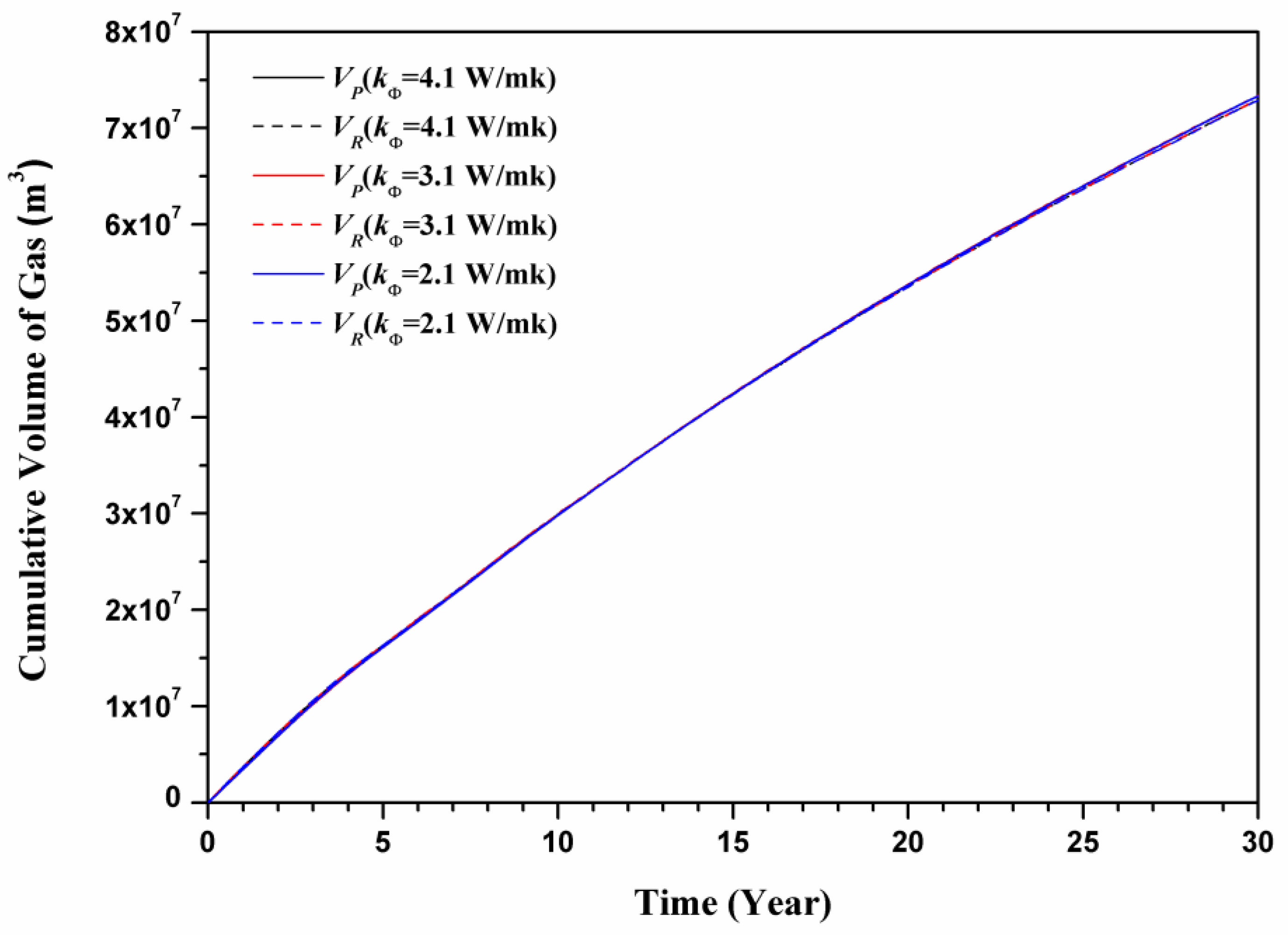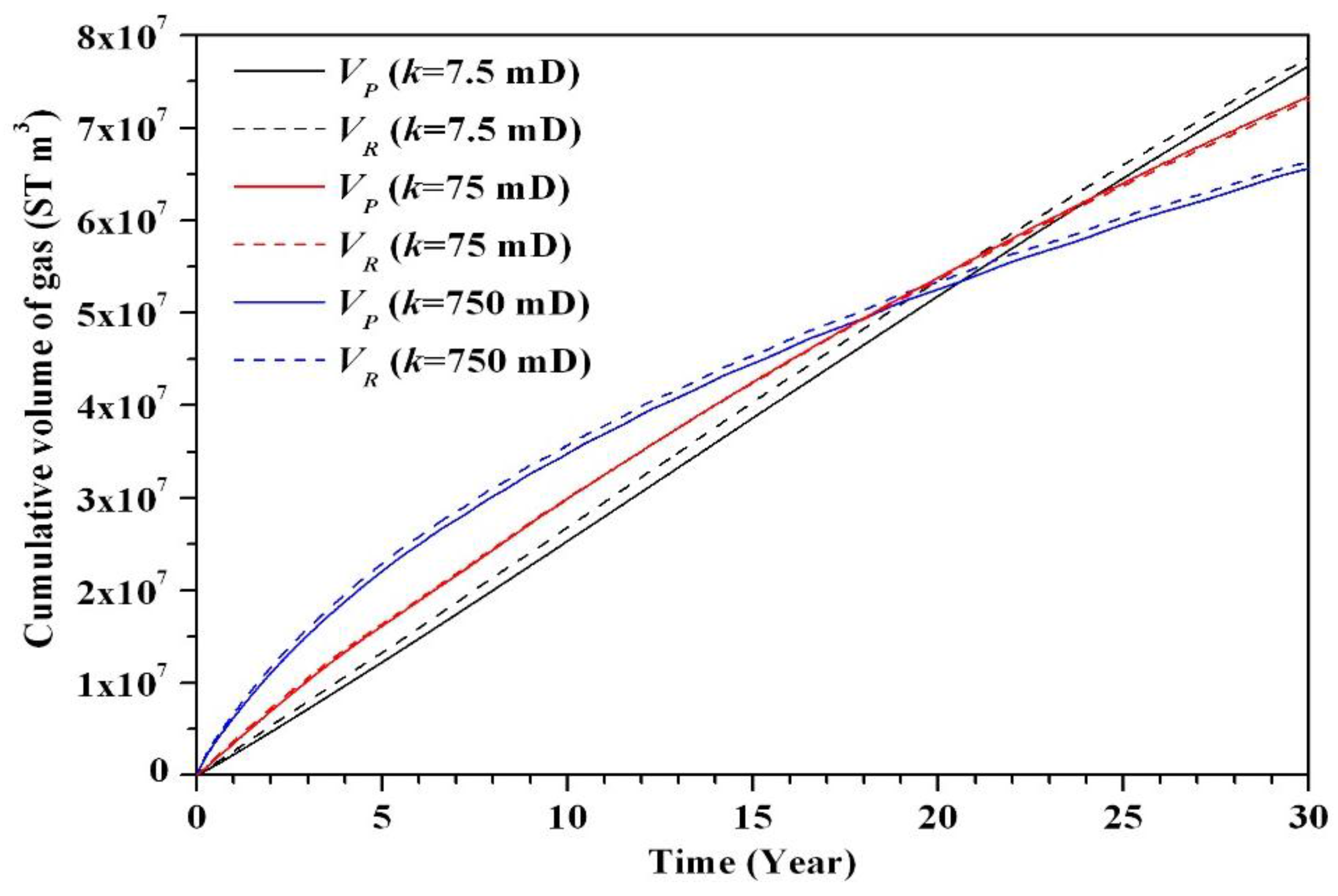Evaluation of Gas Production from Marine Hydrate Deposits at the GMGS2-Site 8, Pearl River Mouth Basin, South China Sea
Abstract
:1. Introduction
2. System Description and Production Strategy
2.1. System Description and Geometry
2.2. Method of Production and Well Design
3. The Numerical Models and Simulation Approach
3.1. The Numerical Simulation Codes
3.2. Domain Discretization
3.3. Boundary and Initial Conditions
3.4. Simulation Process and Approach
3.5. Evaluation Method
4. Production from GMGS2-Site 8 in the Pearl River Mouth Basin: The Reference Case
4.1. Gas and Water Production
4.2. Spatial Distributions of P
4.3. Spatial Distributions of T
4.4. Spatial Distributions of SH
5. Sensitivity Analysis of Production from GMGS2-Site 8 in Pearl River Mouth Basin
5.1. Sensitivity to the Production Pressure PW
5.2. Sensitivity to the Thermal Conductivity kΘ
5.3. Sensitivity to the Intrinsic Permeability k
6. Conclusions
- The total gas production is approximately 7.3 × 107 ST m3 in 30 years. Thus, the average gas production rate in the entire 30 years is 6.7 × 103 ST m3/day, which is much higher than the previous study in the Shenhu Area of the South China Sea by the GMGS-1. Moreover, the maximum gas production rate (9.5 × 103 ST m3/day) has the same order of magnitude of the first offshore methane hydrate production test in the Nankai Though.
- The decrease of the PW can enhance the hydrate dissociation rate. When PW decreases from 4.5 to 3.4 MPa, the volume of gas production increases by 20.5%, and when PW decreases from 3.4 to 2.3 MPa, the volume of gas production increases by 13.6%. Furthermore, the lowest PW is 2.3 MPa, which is lower than the quadruple point of methane hydrate. However, the ice blocking does not happen in this case.
- Production behaviors are not sensitive to the thermal conductivity kΘ.
- In the initial 10 years, the higher k leads to a larger rate of gas production, but the final VP and VR in the case with the lowest k are the highest.
Acknowledgments
Author Contributions
Conflicts of Interest
Notation
| G | thermal gradient within the sea (°C/m) |
| H | depth of the sea water (m) |
| k | intrinsic permeability (m2) |
| keff | effective permeability (m2) |
| krA | aqueous relative permeability (m2) |
| krG | gas relative permeability (m2) |
| kΘC | thermal conductivity (W/m/K) |
| kΘRD | thermal conductivity of dry porous medium (W/m/K) |
| kΘRW | thermal conductivity of fully saturated porous medium (W/m/K) |
| kΘI | thermal conductivity of ice (W/m/K) |
| VP | cumulative volume of produced gas (m3) |
| VR | cumulative volume of released gas (m3) |
| MW | cumulative mass of produced water (kg) |
| P | pressure (MPa) |
| PB | initial pressure at base of HBL (MPa) |
| P0 | atmosphere pressure (MPa) |
| PW | working pressure at the well (MPa) |
| PW0 | initial pressure at the well (MPa) |
| Q | injected heat (J) |
| Qavg | average gas production rate (ST m3/day/m of well) |
| Qinj | heat injection rate (W/m of well) |
| r | radius (m) |
| RGW | the gas to water production ratio (ST m3 of CH4 / m3 of H2O) |
| S | phase saturation |
| t | time (days) |
| T | temperature (°C) |
| T0 | the temperature of the sea floor (°C) |
| TW | injected warm water temperature (°C) |
| TB | initial temperature at the base of HBL (°C) |
| TT | initial temperature at the top of HBL (°C) |
| W | pump work (J) |
| x,y,z | cartesian coordinates (m) |
| SH | hydrate saturation |
| SG | gas saturation |
| XS | the mass fraction of salt in the aqueous phase |
| ΔHc | combustion enthalpy of produced methane (J) |
| ΔPW | driving force of depressurization, PW0—PW (MPa) |
| Δx | discretization along the x-axis (m) |
| Δy | discretization along the y-axis (m) |
| Δz | discretization along the z-axis (m) |
| φ | porosity |
| η | energy ratio |
| λ | van Genuchten exponent—Table 1 |
Subscripts and Superscripts
| 0 | denotes initial state |
| A | aqueous phase |
| B | base of HBL |
| cap | Capillary |
| G | gas phase |
| H | solid hydrate phase |
References
- Sloan, E.D. Fundamental principles and applications of natural gas hydrates. Nature 2003, 426, 353–359. [Google Scholar] [CrossRef] [PubMed]
- Veluswamy, H.P.; Kumar, R.; Linga, P. Hydrogen storage in clathrate hydrates: Current state of the art and future directions. Appl. Energy 2014, 122, 112–132. [Google Scholar] [CrossRef]
- Babu, P.; Kumar, R.; Linga, P. Unusual behavior of propane as a co-guest during hydrate formation in silica sand: Potential application to seawater desalination and carbon dioxide capture. Chem. Eng. Sci. 2014, 117, 342–351. [Google Scholar] [CrossRef]
- Osegovic, J.P.; Blake-Collins, B.; Slattery, I.M.; Max, M.D. Accelerated Hydrate Formation and Dissociation. U.S. Patent 8,334,418, 18 December 2012. [Google Scholar]
- Kumar, A.; Kumar, R. Role of Metallic Packing and Kinetic Promoter in Designing a Hydrate-Based Gas Separation Process. Energy Fuels 2015, 29, 4463–4471. [Google Scholar] [CrossRef]
- Yang, S.H.B.; Babu, P.; Chua, S.F.S.; Linga, P. Carbon dioxide hydrate kinetics in porous media with and without salts. Appl. Energy 2016, 162, 1131–1140. [Google Scholar] [CrossRef]
- Koh, C.A.; Sum, A.K.; Sloan, E.D. Gas hydrates: Unlocking the energy from icy cages. J. Appl. Phys. 2009, 106. [Google Scholar] [CrossRef]
- Sloan, E.D.; Koh, C.A. Clathrate Hydrates of Natural Gases; Marcel Dekker Inc.: New York, NY, USA, 2008. [Google Scholar]
- Bohrmann, G.; Kuhs, W.F.; Klapp, S.A.; Techmer, K.S.; Klein, H.; Murshed, M.M.; Abegg, F. Appearance and preservation of natural gas hydrate from Hydrate Ridge sampled during ODP Leg 204 drilling. Mar. Geol. 2007, 244, 1–14. [Google Scholar] [CrossRef]
- Pohlman, J.W.; Kaneko, M.; Heuer, V.B.; Coffin, R.B.; Whiticar, M. Methane sources and production in the northern Cascadia margin gas hydrate system. Earth Planet. Sci. Lett. 2009, 287, 504–512. [Google Scholar] [CrossRef]
- Ruppel, C.; Boswell, R.; Jones, E. Scientific results from Gulf of Mexico Gas Hydrates joint Industry Project Leg 1 drilling: Introduction and overview. Mar. Petrol. Geol. 2008, 25, 819–829. [Google Scholar] [CrossRef]
- Sain, K.; Rajesh, V.; Satyavani, N.; Subbarao, K.V.; Subrahmanyam, C. Gas-hydrate stability thickness map along the Indian continental margin. Mar. Petrol. Geol. 2011, 28, 1779–1786. [Google Scholar] [CrossRef]
- Moridis, G.J.; Reagan, M.I.; Kim, S.J.; Seol, Y.; Zhang, K. Evaluation of the Gas Production Potential of Marine Hydrate Deposits in the Ulleung Basin of the Korean East Sea. Spe J. 2009, 14, 759–781. [Google Scholar] [CrossRef]
- Kwon, T.H.; Lee, K.R.; Cho, G.C.; Lee, J.Y. Geotechnical properties of deep oceanic sediments recovered from the hydrate occurrence regions in the Ulleung Basin, East Sea, offshore Korea. Mar. Petrol. Geol. 2011, 28, 1870–1883. [Google Scholar] [CrossRef]
- Feng, J.C.; Li, X.S.; Li, G.; Li, B.; Chen, Z.Y.; Wang, Y. Numerical Investigation of Hydrate Dissociation Performance in the South China Sea with Different Horizontal Well Configurations. Energies 2014, 7, 4813–4834. [Google Scholar] [CrossRef]
- Ning, F.; Zhang, K.; Wu, N.; Zhang, L.; Li, G.; Jiang, G.; Yu, Y.; Liu, L.; Qin, Y. Invasion of drilling mud into gas-hydrate-bearing sediments. Part I: Effect of drilling mud properties. Geophys. J. Int. 2013, 193, 1370–1384. [Google Scholar] [CrossRef]
- Liu, C.L.; Meng, Q.G.; He, X.L.; Li, C.F.; Ye, Y.G.; Zhang, G.X.; Liang, J.Q. Characterization of natural gas hydrate recovered from Pearl River Mouth basin in South China Sea. Mar. Petrol. Geol. 2015, 61, 14–21. [Google Scholar] [CrossRef]
- Max, M.D.; Johnson, A.H. Hydrate petroleum system approach to natural gas hydrate exploration. Petrol. Geosci. 2014, 20, 187–199. [Google Scholar] [CrossRef]
- Moridis, G.J.; Collett, T.S.; Pooladi-Darvish, M.; Hancock, S.; Santamarina, C.; Boswell, R.; Kneafsey, T.; Rutqvist, J.; Kowalsky, M.B.; Reagan, M.T.; et al. Challenges, Uncertainties, and Issues Facing Gas Production From Gas-Hydrate Deposits. Spe Reserv. Eval. Eng. 2011, 14, 76–112. [Google Scholar] [CrossRef]
- Li, X.-S.; Wang, Y.; Li, G.; Zhang, Y. Experimental Investigations into Gas Production Behaviors from Methane Hydrate with Different Methods in a Cubic Hydrate Simulator. Energy Fuels 2011, 26, 1124–1134. [Google Scholar] [CrossRef]
- Wang, Y.; Li, X.-S.; Li, G.; Zhang, Y.; Li, B.; Feng, J.-C. A three-dimensional study on methane hydrate decomposition with different methods using five-spot well. Appl. Energy 2013, 112, 83–92. [Google Scholar] [CrossRef]
- Chong, Z.R.; Yang, S.H.B.; Babu, P.; Linga, P.; Li, X.-S. Review of natural gas hydrates as an energy resource: Prospects and challenges. Appl. Energy 2016, 162, 1633–1652. [Google Scholar] [CrossRef]
- Li, X.S.; Yang, B.; Li, G.; Li, B. Numerical Simulation of Gas Production from Natural Gas Hydrate Using a Single Horizontal Well by Depressurization in Qilian Mountain Permafrost. Ind. Eng. Chem. Res. 2012, 51, 4424–4432. [Google Scholar] [CrossRef]
- Chen, D.X.; Wu, S.G.; Dong, D.D.; Mi, L.J.; Fu, S.Y.; Shi, H.S. Focused fluid flow in the Baiyun Sag, northern South China Sea: Implications for the source of gas in hydrate reservoirs. Chin. J. Oceanol. Limnol. 2013, 31, 178–189. [Google Scholar] [CrossRef]
- Li, G.; Li, X.S.; Chen, Q.; Chen, Z.Y. Numerical Simulation of Gas Production from Gas Hydrate Zone in Shenhu Area, South China Sea. Acta Chim. Sin. 2010, 68, 1083–1092. [Google Scholar]
- Li, G.; Moridis, G.J.; Zhang, K.; Li, X.S. The use of huff and puff method in a single horizontal well in gas production from marine gas hydrate deposits in the Shenhu Area of South China Sea. J. Petrol. Sci. Eng. 2011, 77, 49–68. [Google Scholar] [CrossRef]
- Su, Z.; Cao, Y.C.; Wu, N.Y.; Chen, D.F.; Yang, S.X.; Wang, H.B. Numerical investigation on methane hydrate accumulation in Shenhu Area, northern continental slope of South China Sea. Mar. Petrol. Geol. 2012, 38, 158–165. [Google Scholar] [CrossRef]
- Su, Z.; Moridis, G.J.; Zhang, K.N.; Wu, N.Y. A huff-and-puff production of gas hydrate deposits in Shenhu area of South China Sea through a vertical well. J. Petrol. Sci. Eng. 2012, 86–87, 54–61. [Google Scholar] [CrossRef]
- Li, G.; Li, X.S.; Zhang, K.N.; Moridis, G.J. Numerical simulation of gas production from hydrate accumulations using a single horizontal well in Shenhu Area, South China Sea. Chin. J. Geophys. 2011, 54, 2325–2337. [Google Scholar]
- Su, Z.; Cao, Y.C.; Wu, N.Y.; He, Y. Numerical Analysis on Gas Production Efficiency from Hydrate Deposits by Thermal Stimulation: Application to the Shenhu Area, South China Sea. Energies 2011, 4, 294–313. [Google Scholar] [CrossRef]
- Feng, J.C.; Li, G.; Li, X.S.; Li, B.; Chen, Z.Y. Evolution of Hydrate Dissociation by Warm Brine Stimulation Combined Depressurization in the South China Sea. Energies 2013, 6, 5402–5425. [Google Scholar] [CrossRef]
- Li, B.; Li, G.; Li, X.S.; Li, Q.P.; Yang, B.; Zhang, Y.; Chen, Z.Y. Gas Production from Methane Hydrate in a Pilot-Scale Hydrate Simulator Using the Huff and Puff Method by Experimental and Numerical Studies. Energy Fuels 2012, 26, 7183–7194. [Google Scholar] [CrossRef]
- Li, B.; Li, X.S.; Li, G. Kinetic studies of methane hydrate formation in porous media based on experiments in a pilot-scale hydrate simulator and a new model. Chem. Eng. Sci. 2014, 105, 220–230. [Google Scholar] [CrossRef]
- Li, G.; Li, B.; Li, X.S.; Zhang, Y.; Wang, Y. Experimental and Numerical Studies on Gas Production from Methane Hydrate in Porous Media by Depressurization in Pilot-Scale Hydrate Simulator. Energy Fuels 2012, 26, 6300–6310. [Google Scholar] [CrossRef]
- Kneafsey, T.J.; Moridis, G.J. X-Ray computed tomography examination and comparison of gas hydrate dissociation in NGHP-01 expedition (India) and Mount Elbert (Alaska) sediment cores: Experimental observations and numerical modeling. Mar. Petrol. Geol. 2014, 58, 526–539. [Google Scholar] [CrossRef]
- Moridis, G.J.; Kim, J.; Reagan, M.T.; Kim, S.J. Feasibility of gas production from a gas hydrate accumulation at the UBGH2–6 site of the Ulleung basin in the Korean East Sea. J. Petrol. Sci. Eng. 2013, 108, 180–210. [Google Scholar] [CrossRef]
- Li, X.-S.; Yang, B.; Zhang, Y.; Li, G.; Duan, L.-P.; Wang, Y.; Chen, Z.-Y.; Huang, N.-S.; Wu, H.-J. Experimental investigation into gas production from methane hydrate in sediment by depressurization in a novel pilot-scale hydrate simulator. Appl.Energy 2012, 93, 722–732. [Google Scholar] [CrossRef]
- Wang, Y.; Feng, J.C.; Li, X.S.; Zhang, Y.; Li, G. Large Scale Experimental Evaluation to Methane Hydrate Dissociation below Quadruple Point in Sandy Sediment. Applied Energy. 2016, 162, 372–381. [Google Scholar] [CrossRef]
- Wang, Y.; Feng, J.C.; Li, X.S.; Zhang, Y. Analytic Modeling and Large-scale Experimental Study of Mass and Heat Transfer during Hydrate Dissociation in Sediment with Different Dissociation Methods. Energy 2015, 90, 1931–1948. [Google Scholar] [CrossRef]
- Li, X.S.; Wan, L.H.; Li, G.; Li, Q.P.; Chen, Z.Y.; Yan, K.F. Experimental Investigation into the Production Behavior of Methane Hydrate in Porous Sediment with Hot Brine Stimulation. Ind. Eng. Chem. Res. 2008, 47, 9696–9702. [Google Scholar] [CrossRef]
- Li, G.; Li, X.S.; Tang, L.G.; Zhang, Y. Experimental investigation of production behavior of methane hydrate under ethylene glycol injection in unconsolidated sediment. Energy Fuels 2007, 21, 3388–3393. [Google Scholar] [CrossRef]
- Bai, D.S.; Zhang, X.R.; Chen, G.J.; Wang, W.C. Replacement mechanism of methane hydrate with carbon dioxide from microsecond molecular dynamics simulations. Energy Environ. Sci. 2012, 5, 7033–7041. [Google Scholar] [CrossRef]
- Komatsu, H.; Ota, M.; Smith, R.L.; Inomata, H. Review of CO2-CH4 clathrate hydrate replacement reaction laboratory studies—Properties and kinetics. J. Taiwan Inst. Chem. E 2013, 44, 517–537. [Google Scholar] [CrossRef]
- Konno, Y.; Jin, Y.; Shinjou, K.; Nagao, J. Experimental evaluation of the gas recovery factor of methane hydrate in sandy sediment. RSC Adv. 2014, 4, 51666–51675. [Google Scholar] [CrossRef]
- Moridis, G.J.; Collett, T.S.; Boswell, R.; Kurihara, M.; Reagan, M.T.; Koh, C.; Sloan, E.D. Toward Production From Gas Hydrates: Current Status, Assessment of Resources, and Simulation-Based Evaluation of Technology and Potential. Spe Reserv. Eval. Eng. 2009, 12, 745–771. [Google Scholar] [CrossRef]
- Birkedal, K.A.; Freeman, C.M.; Moridis, G.J.; Graue, A. Numerical Predictions of Experimentally Observed Methane Hydrate Dissociation and Reformation in Sandstone. Energy Fuels 2014, 28, 5573–5586. [Google Scholar] [CrossRef]
- Kowalsky, M.B.; Moridis, G.J. Comparison of kinetic and equilibrium reaction models in simulating gas hydrate behavior in porous media. Energy Convers. Manag. 2007, 48, 1850–1863. [Google Scholar] [CrossRef]
- Su, Z.; He, Y.; Wu, N.Y.; Zhang, K.N.; Moridis, G.J. Evaluation on gas production potential from laminar hydrate deposits in Shenhu area of south China sea through depressurization using vertical wells. J. Petrol. Sci. Eng. 2012, 86–98. [Google Scholar] [CrossRef]
- Yamamoto, K. Japan Completes First Off shore Methane Hydrate Production Test—Methane Successfully Produced from Deepwater Hydrate Layers. Fire Ice 2013, 13, 1–2. [Google Scholar]
- Li, G.; Moridis, G.J.; Zhang, K.N.; Li, X.S. Evaluation of Gas Production Potential from Marine Gas Hydrate Deposits in Shenhu Area of South China Sea. Energy Fuels 2010, 24, 6018–6033. [Google Scholar] [CrossRef]
- Li, X.S.; Zhang, Y.; Li, G.; Chen, Z.Y.; Yan, K.F.; Li, Q.P. Gas hydrate equilibrium dissociation conditions in porous media using two thermodynamic approaches. J. Chem. Thermodyn. 2008, 40, 1464–1474. [Google Scholar] [CrossRef]




















| Parameter | Value |
|---|---|
| Layer thicknesses and porosities | As in Figure 4 |
| Hydrate saturation of HBL | As in Figure 4 |
| Initial pressure at top of HBL (PT) | 8.11 MPa |
| Initial temperature at top of HBL(TT) | 277.60 K |
| Initial temperature at base of HBL (TB) | 281.53 K |
| Water depth | 798 m |
| Intrinsic permeability of sediment of each layer | As in Figure 4 |
| Capillary pressure model [35] | Pcap = −P01 [(S×)−1/λ−1] 1−λ S× = (SA − SirA)/(SmxA − SirA) |
| P01 [23] | 105 Pa |
| λ | 0.45 |
| Dry thermal conductivity (kΘRD) (all formations) [23] | 1.0 W/m/K |
| Wet thermal conductivity (kΘRW) (all formations) [23] | 3.1 W/m/K |
| Composite thermal conductivity model | kΘC = kΘRD + (SA1/2 + SH1/2) (kΘRW−kΘRD) + φSIkΘI |
| Relative permeabilityModel [20] | krA = (SA×)n krG= (SG×)nG SA×= (SA − SirA)/(1 − SirA) SG×= (SG − SirG)/(1 − SirA) |
| n [23] | 3.572 |
| nG [23] | 3.572 |
| SirG [23] | 0.05 |
| SirA [23] | 0.30 |
| Sea floor temperature T0 [23] | 277.15 K |
| Geothermal gradient G [23] | 0.045 K/m |
| Water salinity (mass fraction) | 3.50% |
© 2016 by the authors; licensee MDPI, Basel, Switzerland. This article is an open access article distributed under the terms and conditions of the Creative Commons by Attribution (CC-BY) license (http://creativecommons.org/licenses/by/4.0/).
Share and Cite
Wang, Y.; Feng, J.-C.; Li, X.-S.; Zhang, Y.; Li, G. Evaluation of Gas Production from Marine Hydrate Deposits at the GMGS2-Site 8, Pearl River Mouth Basin, South China Sea. Energies 2016, 9, 222. https://doi.org/10.3390/en9030222
Wang Y, Feng J-C, Li X-S, Zhang Y, Li G. Evaluation of Gas Production from Marine Hydrate Deposits at the GMGS2-Site 8, Pearl River Mouth Basin, South China Sea. Energies. 2016; 9(3):222. https://doi.org/10.3390/en9030222
Chicago/Turabian StyleWang, Yi, Jing-Chun Feng, Xiao-Sen Li, Yu Zhang, and Gang Li. 2016. "Evaluation of Gas Production from Marine Hydrate Deposits at the GMGS2-Site 8, Pearl River Mouth Basin, South China Sea" Energies 9, no. 3: 222. https://doi.org/10.3390/en9030222
APA StyleWang, Y., Feng, J.-C., Li, X.-S., Zhang, Y., & Li, G. (2016). Evaluation of Gas Production from Marine Hydrate Deposits at the GMGS2-Site 8, Pearl River Mouth Basin, South China Sea. Energies, 9(3), 222. https://doi.org/10.3390/en9030222





